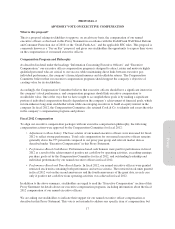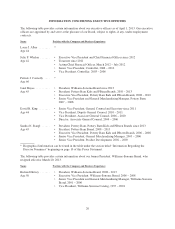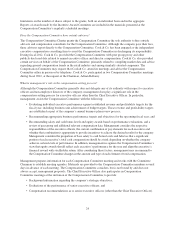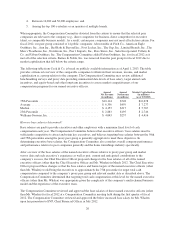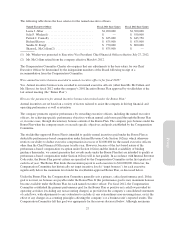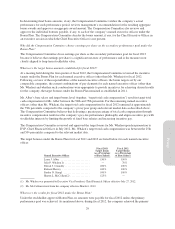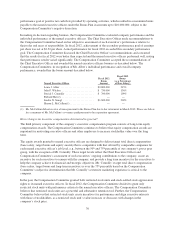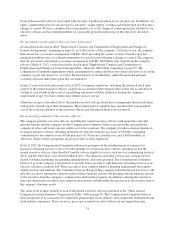Pottery Barn 2012 Annual Report Download - page 119
Download and view the complete annual report
Please find page 119 of the 2012 Pottery Barn annual report below. You can navigate through the pages in the report by either clicking on the pages listed below, or by using the keyword search tool below to find specific information within the annual report.
What are the components of executive compensation?
The Compensation Committee considers three major elements of “direct” pay in the executive compensation
program:
• Base salary;
• Annual incentive opportunities; and
• Long-term incentives.
The Compensation Committee believes that offering the executive team a total compensation package with a
significant pay-for-performance component helps achieve the company’s objective of creating value for its
stockholders. Each of the three major elements in the executive compensation program is discussed in detail
below, but in general, this means:
• Base salaries are competitive with comparable public retail companies with respect to similar positions, to
create an incentive for executives to join and remain with the company;
• Annual incentive opportunities are based principally on the company’s overall corporate performance and
the executive’s individual performance. This results in the company’s superior performers receiving
greater compensatory rewards and lesser performers receiving lower compensatory rewards. We believe
the structure of our annual incentive opportunities fosters a performance-driven culture; and
• Long-term incentives, such as equity compensation awards, are structured to encourage our executive
team to work toward long-term sustained growth and success from the perspective of owners of the
company, to reward executives and other key employees for maximizing long-term stockholder value,
and to provide incentives to remain with the company.
The named executive officers also receive certain retirement and other benefits, as well as perquisites and other
personal benefits as described below. We consider these perquisites in addition to the major elements of
compensation in determining appropriate total compensation.
Does the Compensation Committee compare the company’s compensation practices to those of other companies?
Yes. The compensation practices of other companies within the retail industry are relevant to establishing the
company’s compensation programs and executive compensation for each year so that we can attract and retain
qualified executive and managerial talent in a competitive marketplace.
The Compensation Committee strives to ensure that the company’s total compensation packages and executive
compensation are aligned with market pay levels and practices. In order to achieve such goals, the Compensation
Committee takes into account the relationships among base salary, short-term incentive compensation and long-
term equity compensation at other companies considered to be comparable each year, collectively referred to as
“comparable companies” or our “proxy peer group.”
Our proxy peer group was determined for fiscal 2012 by the Compensation Committee based on the following
general guiding criteria, which reflected the company’s profile at the time the proxy peer group was selected:
1. Company Classification in the Global Industry Classification Standard (GICS) in one of the following:
• Home Furnishing Retail;
• Apparel Retail; or
• Department Stores;
2. Revenues between $1.8 billion and $7.3 billion;
3. Market capitalization greater than $800 million and less than $20 billion;
25
Proxy




